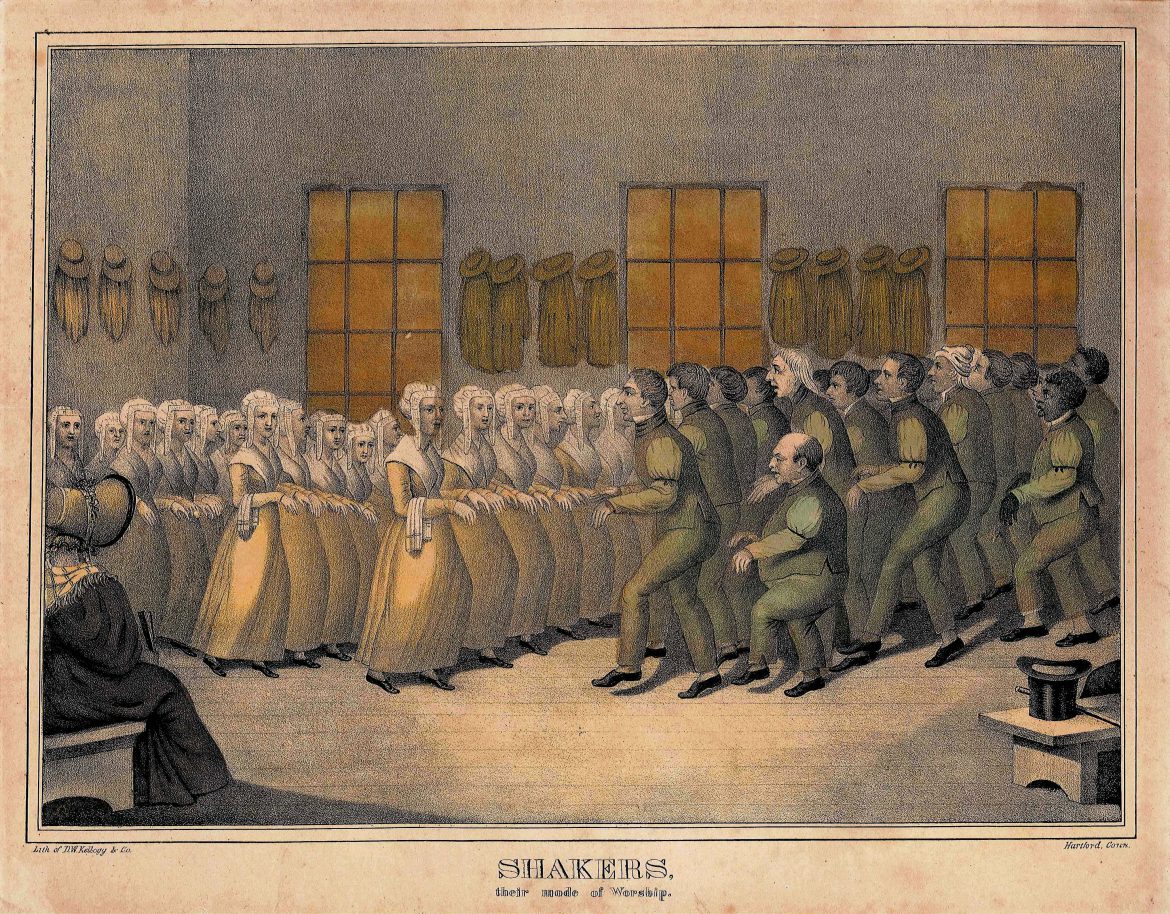
Lithograph, “Shakers, their mode of Worship,” D. W. Kellogg and Company, Hartford, CT, ca. 1835, Shaker Museum | Mount Lebanon,1958.10574.1
There are many versions of this illustration, published in dozens of works on the Shakers. The history of its publication by various printmakers and printers has been well told by Robert P. Emlen in his article titled “The Shaker Dance Prints,” in Imprint: Journal of the American Historical Print Collectors Society in the autumn of […]

Lithograph, “Shakers, their mode of Worship,” D. W. Kellogg and Company, Hartford, CT, ca. 1835, Shaker Museum | Mount Lebanon,1958.10574.1
There are many versions of this illustration, published in dozens of works on the Shakers. The history of its publication by various printmakers and printers has been well told by Robert P. Emlen in his article titled “The Shaker Dance Prints,” in Imprint: Journal of the American Historical Print Collectors Society in the autumn of 1992. Emlen, in establishing the order in which versions of the print appeared for sale and in magazines, settled on a date around 1829 or 1830 for the earliest known printing. The print shown here, “Shakers, their mode of Worship,” published by D. W. Kellogg & Company, dates from sometime between 1832/1833 and 1840. It is a hand-colored lithograph and was sold as an individual print.
The diminutive man at the head of the second row of Shakers is likely Brother David Rowley. It was just after Christmas 1809 when David Rowley left his wife and young son in the world to unite with the Shakers. Brother David was a trained cabinetmaker when he joined the North Family at Mount Lebanon, New York, and continued in that work as a Shaker until his death of influenza in the fall of 1855. Shaker journals record Brother David’s height at four feet ten and three-eighth inches, and at the time the artist attended Shaker meeting and made his sketch for the print, Brother David was around fifty years of age. As a member of the North Family, “our good little brother,” as the Shakers referred to him, would have been at the community’s public meeting – the only meeting the author would have been allowed to attend. In June of 1830, Brother David moved from the North to the Church Family to work as that family’s cabinetmaker. As a member of the Church Family, Brother David would not have attended public meeting. This change of residence may help narrow the date when the original version of the print was made by providing the latest date when the artist would have seen Brother David in meeting.
One of the reasons this print has so often been used is the presence of the two African American men on the far right side of the image. The Shakers are well known for their willingness to include all, regardless of race or national origin, who were willing to bear the cross of a celibate life, live out of the common course of the world, and give themselves completely to the Church. Whereas a number of African Americans united with the Shakers in Kentucky and Ohio, the numbers were much smaller in the New England communities. At Mount Lebanon, a community of as many as five to six hundred members, for example, there were probably never even a dozen African American Shakers living there at any given time. One African American Brother that is documented to be a member of the North Family at the time the artist depicted the meeting was Brother Tower Smith. Brother Tower’s arrival in the family is described in the language of the day by Elder Calvin Green on August 3, 1821: “The Brethren reap & stack the rye on Amos’s mountain … a Black man from Hudson here, by name of Tower Smith wants to live with us — he had some faith years ago. We finish pulling flax.” Brother Tower was taken into the family and is mentioned a few times over the years before April, 1834, when Brother Abel Knight took him to Hudson, where, the journalist records, “like most others, [he] wants to be with those who were most congenial to his sense & state.” The journalist concludes with the comment, “poor old man I hope he may not spend the remainder of his days in suffering.”
It is interesting to note that none of the sisters were drawn with enough “character” to distinguish them one from another, whereas the artist seemed to take a lot of care to find unique characteristics in the brothers. This may have had to do with where he sat and how well he could see the sisters. While there are probably not many more identifiable characters in “The Shakers, their mode of Worship” – although there must be a story about a Shaker brother who wears a knit hat to meeting or, of course, the other African American brother – the more we are able to populate these images with real people, the better we are able to understand the Shaker experience.
[…] Around this time last year, we looked at this illustration of the Shakers’ worship and suggested that as research on the Shakers continues there is an opportunity to bring forth the personal stories of more and more of those who lived that unique committed life. At that time we explored the possibility of identifying several of the Shakers portrayed in the illustration – specifically the short Shaker brother and the two brothers presented by the artist as persons of color. (In previous research on this topic and generally in research about racial inclusion among the Shakers, these brothers are identified as African-American; however, the Shakers were often not specific in describing the race of individual members, so they are referred to here as persons of color.) […]